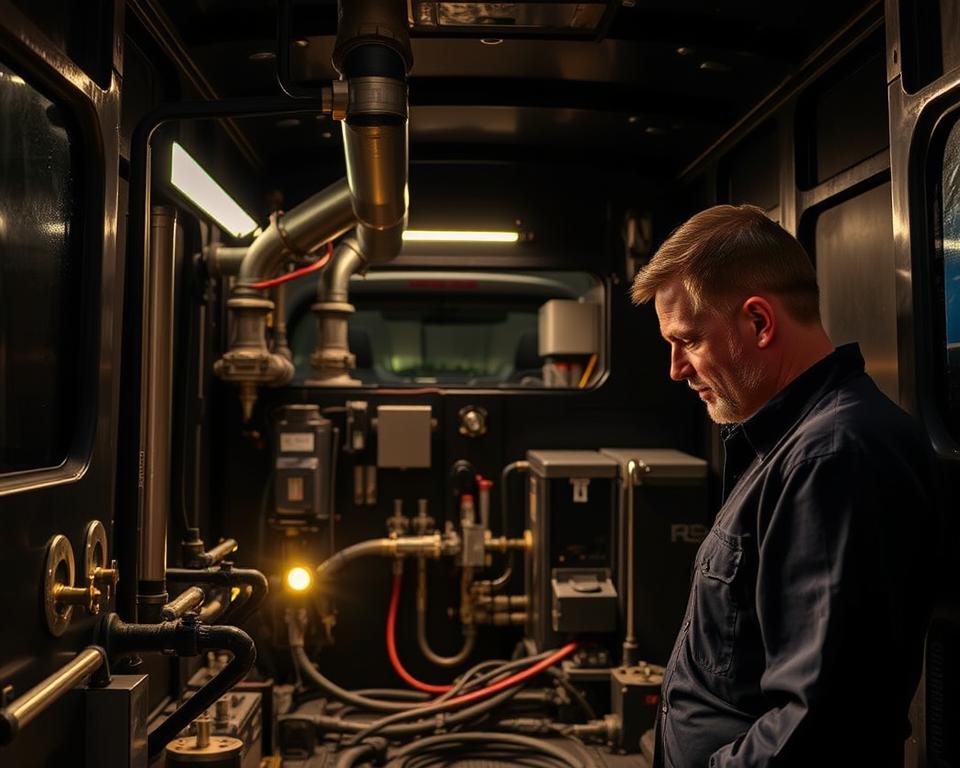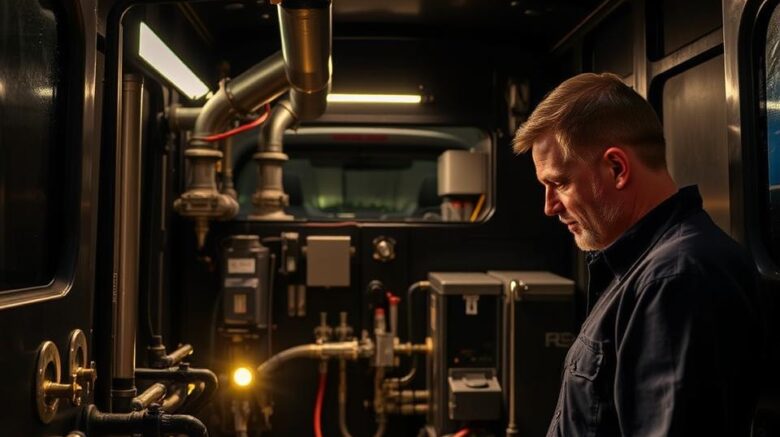Camper Water Tank plus Pump: – Essential Guide
Have you ever asked how seasoned RVers ensure perfect water flow while boondocking? It’s fundamentally tied to your RV water Tank & Pump. If you’re venturing into the national-park circuit or just a weekend retreat, commanding your RV’s water system is crucial. The following guide we dive into the must-knows: the components, upkeep, and best practices for worry-free travel. Grasping each element, from the pipework to Tank filling, secures water is always at your disposal during your journeys – RV pumping near me.
Core Takeaways
- Getting familiar with the RV fresh-water setup optimises your travel fun.
- The RV fresh-water Tank & Pump are pivotal for a reliable water supply.
- Routine upkeep protects the longevity of your RV plumbing.
- Knowing how to fill your reservoir properly can prevent future issues.
- Diagnosing your water Pump can save you from unexpected problems.
Understanding RV Water Systems
RV water systems consist of two principal parts: the potable-water setup and the wastewater mechanism. The fresh side houses several critical pieces like the water Tank, Pump, and faucets, echoing domestic plumbing but adapted to the mobile needs of living on the move.
Ensuring safe water is paramount for the system’s performance. It protects the health of all passengers. It’s important to keep the RV plumbing in top shape through scheduled maintenance – such as proper drainage to prevent leaks and other issues. Proactive inspections help RV enthusiasts dodge water-related surprises during their journeys.

The Role of the RV Fresh-Water Tank
The RV water Tank is central for a smooth journey. It holds the fresh water required for drinking, cooking, and cleaning. The volume of this Tank varies with each RV model, impacting how much water can be stored – and directly dictates how long you can stay off-grid before needing a refill.
Ensuring the RV water Tank clean is essential. Routine cleaning keeps at bay dangerous contaminants, so the water stays safe for use. Ignoring maintenance can encourage bacteria or algae growth, making the water hazardous.
Appreciating the RV Tank’s role enhances water management during trips. Proper upkeep and frequent refills ensure a worry-free experience. It’s crucial to have ample water for all travel needs, ensuring a smooth RV adventure.
Filling Your RV Water Tank
Filling your RV water Tank requires attentive action to guarantee it’s done correctly. There are two main methods: gravity-feed filling and city-pressure filling. Understanding these methods greatly enhances your RV water routine.
Gravity filling is direct. You just need a food-grade water hose. Hook up this hose to a water source, then to the Tank’s opening, and allow gravity take over. Always keep an eye on the water level to prevent spills.
Pressure filling involves a city water connection, offering faster results. You must use a pressure regulator to govern water flow. Attach the hose from the municipal source to your RV. This method ensures quick and steady supply to your Tank.
Choosing method you select, follow these important safety tips: Consistently monitor the Tank when filling to prevent overflow, and use safe water to avoid health issues. Knowing these filling and safety techniques will render your RV trips even more enjoyable.
RV Water Tank and Pump: Parts in Focus
The RV water Tank and Pump are crucial to any RV’s plumbing system, delivering a reliable and efficient water supply for all your needs. The RV water Pump’s main job is to push water from the Tank, so clean water is always available. That’s key for cooking, cleaning, and showering.
RV plumbing utilises different Pump types, each with unique benefits. Diaphragm pumps are favoured for their consistent water pressure, while centrifugal models are prized for simplicity and energy thrift. It’s wise to weigh flow rate, noise, and installation ease when picking your Pump.
To sum up, the RV Tank-Pump pair are irreplaceable to your water system’s operation. A dependable Pump delivers strong pressure and smooth flow, improving your overall travel experience.
Selecting the Right RV Water Pump
Choosing the appropriate RV water Pump is key for your plumbing’s optimal performance. When picking a Pump, weighing several points is crucial for a positive camping experience. Ensuring it matches your RV’s water system is key.
Keep these primary aspects in mind:
- Flow Rate: Select a Pump with a flow rate that matches your usage requirements. A stronger flow means faster reservoir refills.
- Pressure Ratings: Your RV’s multiple fixtures determine the needed pressure levels. Go with a Pump whose specs match those needs for smooth operation.
- Noise Levels: Noise can be an issue with some Pumps. If you prize silence, contrast models for their noise output.
Brands like SHURflo and VEVOR are high on the list for many RVers, and they offer stand-out perks. A thoughtful assessment of these brands will help your decision-making process.
Understanding these factors is not only crucial for the right purchase but also equips DIY enthusiasts with key know-how for upkeep and replacements.
Hooking Up to City Water for Your RV
Connecting your RV to city water provides an uninterrupted supply of fresh water, letting you bypass just using your Tank. This delivers a more enjoyable camping experience. Be sure to follow specific steps for a trouble-free hookup.
First, find the city water connection port on your RV. It’s commonly marked by a white or black connector, sometimes labelled for ease. Use a potable water hose made for RVs; this grade of hose protects your water safe from contaminants.
It’s essential to attach a pressure regulator before making the connection. This device safeguards your plumbing by controlling the water pressure. With the regulator in place, link the hose from it to the water source.
Once connected, keep an eye on the water pressure. Maintain a steady, gentle flow to prevent hose damage. Check your hoses regularly for any wear or leaks and promptly replace parts as needed.
Adhering to these steps for city hookup boosts your camping convenience and assists in maintaining your RV’s condition.
Looking After Your RV Water Tank
Ensuring your RV’s water Tank is properly maintained is vital for safe, clean water while on the road. A sound Tank helps prevent bacterial growth and contamination. First up, periodically sanitise the Tank: combine water with a bit of bleach for an efficient residue-free clean.
It’s crucial to check leaks and manage Tank pressure. Routine checks can identify problems early, sparing expensive fixes. A maintenance routine maintains the water system in prime condition.
To optimise maintenance, create a checklist:
- Check water levels and quality regularly.
- Sanitise the Tank bi-annually with a bleach solution.
- Inspect for cracks in the Tank.
- Monitor Tank pressure and Pump function.
- Flush the Tank to clear any sediment buildup.
RV Water Pump Troubleshooting
RV water Pump issues can be vexing, derailing travel plans in a flash. Encountering strange noises, dealing with low pressure, or facing complete Pump failure are typical problems. Knowing how to troubleshoot them can greatly improve your trips.
Hearing odd sounds from your Pump often signals a problem. Start : check for loose connections and secure them. When you face low water pressure, checking hoses and fittings for leaks. Even a small leak can greatly affect flow, prompt troubleshooting is critical.
If your Pump quits altogether, test electrical connections. Begin by examining the Pump’s fuse. If the fuse is fine, continue diagnosing for wear or damage.
A systematic routine identifies and resolves water system issues. Regular maintenance and inspection secure hassle-free journeys.
| Issue | Possible Cause | Suggested Solution |
|---|---|---|
| Strange Noises | Loose connections | Tighten fittings |
| Low Pressure | Leaky hoses/fittings | Find & seal leaks |
| Pump Failure | Electrical fault | Check fuse/wiring |
| No Water Flow | Blocked lines | Flush obstructions |
Tips for Smart RV Water Use
Camping in isolated areas often means limited water access. Wise use in your RV is key. By embracing smart conservation tactics, you don’t just manage resources well but also elevate camping satisfaction.
To squeeze every drop of water while travelling, consider these tips:
- Take quick showers – aim for under five minutes.
- Install water-saving fixtures like low-flow showerheads and faucets.
- Reuse grey water: dishwater can flush toilets or water plants.
- Monitor Tank levels regularly to avoid overflow.
- Plan water stops in advance: know filling stations along your route.
Wrapping Up
Understanding the ins and outs of your RV water systems is key to a successful travel adventure. The Tank and Pump remain at the heart of this, demanding routine upkeep. By looking after these systems, you ensure a dependable supply and avoid potential snags.
Diligent troubleshooting and checks limit stress and save time. Being proactive about upkeep is crucial, especially when you’re far from help. Proper care enables you to maximise water use, boosting comfort for everyone.
On your next outing, use this guide to command your RV’s water systems. Smart decisions about plumbing and equipment prepare you to enjoy the freedom of the road. Here’s to joyous and smooth travels ahead!
